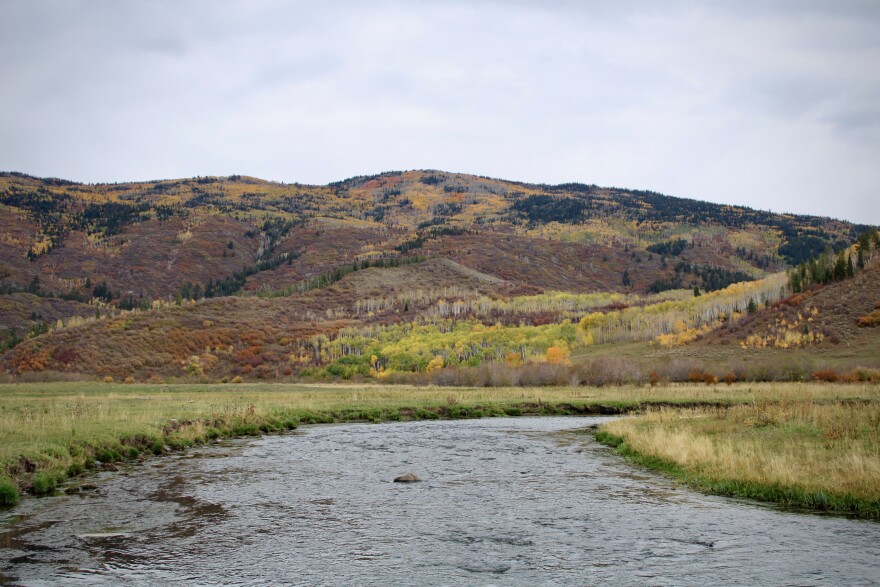When you've been coming to the same place for decades, it's easy to notice changes. On this ranch near Steamboat Springs, Colorado, the tell-tale signs of drought are everywhere. Todd Hagenbuch stands beside a silent, dusty creek bed, where golden grasses and scrub are beginning to reclaim the thin channel.
"Typically you'd see a little water in this throughout the summer," he said. "It's been dry all summer long."
Hagenbuch's family has been ranching this land for 75 years. This creek runs into the Yampa River, which snakes through the property.
"It's quite a shocker," he said. "I'm in my mid-40s, I remember coming up here as a little kid, moving some rocks around and playing in the water. My kids this year did not get that opportunity, and that's kind of a sad state of affairs."
On a working ranch, it's more than just sad. That kind of scarcity can cut into the bottom line. This year, ranchers in the headwaters of the Yampa have had trouble producing enough hay to make it through the winter. Instead, they have to buy tons of hay, trucked in from other areas. This is not the first year that dry conditions have sowed economic unease, and it likely won’t be the last.

"If you can get a couple good years with some of the bad years," Hagenbuch said, "you can overcome some of that. But we're due for a good year."
Growers in the West have persisted through the ups and downs of dry years for a long time, but a two-decades-long trend of drought in the region is now entrenching itself with no clear end in sight.
This year is unlikely to bring any major relief.
Forecasters say this winter will be shaped by "La Niña," a weather phenomenon during which cold water off the Pacific coast alters temperature and precipitation patterns over the Western U.S. Its effects are hardly guaranteed, but typically mean a colder, wetter winter for the northwestern portion of the country, and a warmer, drier winter in the Southwest. The dividing line often falls in the middle of Colorado.
"In general it means towards the northern mountains would be more likely to have a better winter season and the southern mountains — the San Juan Mountains, the Sangre de Cristos — might not be able to get as much," said Becky Bolinger, assistant state climatologist at Colorado State University.
She cautioned that weather is hard to predict with a high degree of certainty, describing the area’s erratic patterns as "a crapshoot," but historical records suggest it will likely leave the Colorado River basin warmer and drier than normal this coming winter.

"While we do depend on the (summer) monsoon season," Bolinger said, "especially to help fill up those soils before we enter the cold season, we really need that snowpack to kind of really dig out like Arizona did with its monsoon season."
Bolinger was alluding to this year's historically wet summer in Arizona — where parts of a state with millions of Colorado River water users were drenched with record-setting rain totals. Tucson, for example, saw its wettest calendar year in recorded history. July was the state's second-wettest month of all time.
A recent conversation with Erinanne Saffell, Arizona state climatologist at Arizona State University, was soundtracked by a late summer storm.
"A cell just opened up over my house," she said over Zoom. "It's raining cats and dogs out there, and I'm wanting to go look outside the window."
But La Niña conditions mean storms like that one are unlikely to last. La Niña conditions consistently deliver hot, dry winters to Arizona — more predictably than conditions in Colorado. Case in point — last winter, where La Niña left the area "very, very, very dry."
"If we have that again," Saffell said, "then we're going to maintain that long-term drought. We don’t have the opportunity to mitigate some of that."
Ultimately, even a strong, rainy winter in the desert wouldn’t turn drought around in any lasting capacity.
"Arizona has been in these drought conditions since the mid '90s," Saffell said. "To fully come out of those conditions, we would need to have a few seasons of above-average precipitation."
And in the grand scheme of the Colorado River basin, wet seasons in Arizona are literally a drop in the bucket. Before going on to feed farms and taps all the way down to Mexico, the majority of the river's water starts as rain and snow high in the mountains of Wyoming and Colorado. In the long term, Bolinger says climate change will bring shorter winters, warmer temperatures and drier soil.

"We know that we are going to have increasing frequency of droughts and we have seen that in these past 20 years," she said. "That is something that is going to continue."
In Steamboat Springs, that dry creek bed on Todd Hagenbuch’s property will not be the last one to lose its water. He sees it as a sign of things to come in other parts of the West.
"Where this would normally be contributing just a little bit, which contributes to the river, which contributes then to the Colorado River and to the overall basin," he said. "It's just another signal that things are dry and we shouldn’t expect as much water in the river when places like this are drying up."
Turning things around in the Colorado River basin and bringing more water to the people who depend on it will take years of above-average rain and snow where it matters most.
This story is part of ongoing coverage of water in the West, produced by KUNC in Colorado and supported by the Walton Family Foundation. KUNC is solely responsible for its editorial coverage.
Copyright 2021 KUNC. To see more, visit KUNC. 9(MDEwODI1MTE0MDEzNTk1NjQ4ODc4OTk0Ng004))



